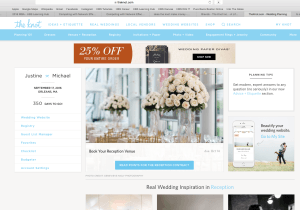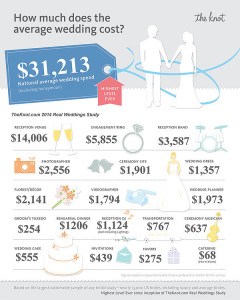The Knot : Maximizing Value in an Evergreen Industry

“Amazing news! Congrats! Where do you want to get married? Have you thought about destination wedding? Are you thinking Spring or Fall wedding? What color will your bridesmaids will wear??” – My future mother-in-law…30 minutes after my fiancé proposed.
Planning a wedding? If so, you’ve most likely visited TheKnot.com (an XO Group brand) at some point during the process (8 out of 10 brides visit and use The Knot). With 6.1 million monthly unique visitors and over two times the relative market share of its closest competitor (WeddingWire), The Knot has become the #1 wedding website offering its users extensive listings on local wedding services (venues, bands, caterers, etc.), personalized planning tools for managing budget and calendar, images/articles for trends and inspiration, general wedding/etiquette advice, active community forums, and product suggestions supplemented through The Knot’s ecommerce shop.
Value Creation:
The Knot has essentially become the largest, trusted online wedding resource. The platform creates value through its ability to cater to a variety of users with varying levels of need — from being the “one stop shop” for individuals who need lots of handholding through the planning process (e.g. “I just got engaged, what do I do next?”), to being the “only-as-needed” directory for those who simply want to do research trends or look up a vendor. Rather than relying on the referrals and contacts of a sole wedding planner or a single vendor, users of The Knot have access to some 300,000 local vendors across the country and utilize the thousands of user reviews to best compare their options. With the average wedding cost now at $31,213, The Knot offers the opportunity to compare services easily and reliably; by creating a platform that allows users to sort by reviews, price, service, theme, and location, The Knot has helped streamline and alleviate a lot of the stress that often accompanies planning such an important life event.
Value Capture:

Despite its large and growing user base, The Knot does not charge users to access the platform. Some value is captured from users through The Knot Shop (its ecommerce platform), it’s print magazine, and its wedding website business, where users can pay to upgrade from the largely freemium model for customized website features. However, The Knot captures most of its value from local and national vendors looking to advertise their services to the millions of users on the site and in their print magazines. Vendors can pay additional fees to receive preferential/sponsored search listings with higher visibility.
Network Effects:
Like many other platforms, we see direct network effects coming into play with the users on The Knot. As the user base grows, the value derived from other users increases through the additional reviews provided and increased online community engagement (e.g. “the more reviews and personal stories I can read about this user’s experience with this band, the better I feel about reaching out to and booking the band.”).
We can observe indirect network effects between The Knot’s user community and vendors/third-party companies. Vendors and other companies that are targeting young couples stand to benefit from The Knot’s large user base through more targeted marketing as many of the users are likely to visit The Knot to research a variety of tangentially related aspects to weddings on The Knot.
Layers and Layers .. and Layers of Network Effects?
XO Group (parent company of The Knot) has clearly realized the value in creating a platform with huge network effects – especially in an “evergreen” industry that continually renews itself year after year (an average 2.3 billion marriages each year in the U.S.). The XO Group has sought to build on its existing community by offering an even broader proposition: assisting its users in other major milestones in life after the wedding through The Bump (for expecting/first time parents) and The Nest (for first time home owners).




Thanks for the post! I agree that the Knot has done a great job of becoming the website for brides and couples looking for wedding information and planning resources. What I find interesting, though, is that in order to grow the Knot also had to invest a lot in content generation – which is different from typical two-sided market platforms in some other industries. That is, it seems that it was difficult for the Knot to grow purely on the basis of allowing couples to search vendors – instead, it had to attract users by offering interesting articles, inspirational photos and ideas, etc. This may be because pure two-sided platforms work particularly well for products or services that are relatively commoditized – partially because if it doesn’t quite work out, it’s not that big a deal. A wedding, on the other hand, is meant to be a once-in-a-lifetime experience, and couples want to make sure that the choices they make are perfect. So while having a larger user base with more reviews and comments is useful, many people may still prefer to choose their wedding vendors in person and often based on recommendations of close friends and family. Therefore, while the Knot does have this directory/platform aspect, and while I’m guessing its users certainly use this feature to search for vendors, I think the site’s content plays a major role in attracting users. This is different from platforms like OpenTable, for instance, which doesn’t really have to invest in content, but can remain mostly functional/transactional.
I like XO’s business and do agree that content is key in providing a differentiated service vs. Amazon or other larger e-commerce platforms. One aspect that shouldn’t be downplayed is the viral factor of the registry business. Each couple that signs up leads to dozens if not hundreds of new leads, as the couple’s registry invitees provide their information when they purchase gifts.
Where I do worry about XO’s core business is in providing the highest quality offering. Good content is available across many platforms and at the individual product level the Knot is far from the best place to find peer reviews. Ease of use, reliability, and technological innovation (for example being able to use an app to manage the registry, using your phone to scan items at any retail store and add them to your registry, or being able to pin any item from any website to your registry) will be the keys to gaining or maintaining market share.
I also think that different couples with different tastes and economic means will gravitate to the offering that fits them best. I see an opportunity for multiple players in the industry who cater to different customer cohorts. Said another way, I don’t necessarily believe the network effects are strong enough to justify dominant market share by a single platform.
I too like the XO group’s business as I think they have a lot of growth potential on the value capture side. Not only do they have more room to grow in their traditional revenue generating categories (e.g., advertising from local vendors, affiliate marketing tied to registries, etc.) but there is also tremendous value to the data they are collecting through their various businesses. Many different companies are keen to target customers at the time they are going through major life changes. Think about all of the big changes that happen when you get married, buy a house, have a baby, etc. and all of the auxiliary businesses that would be interested in this — for example, when couples get married they often combine bank accounts, get a new credit card, move, etc. It would be very valuable to other companies to know when this is happening in their target customer’s life so they can proactively serve them offers and advertising. The key to all of this, of course, is to have the members and the data to begin with so I share the concerns voiced above on how well can XO continuously attract new members each year. Content is obviously key but its also crucial to develop a comprehensive digital footprint as they way brides-to-be are researching is changing rapidly thanks to pinterest, mobile, etc.